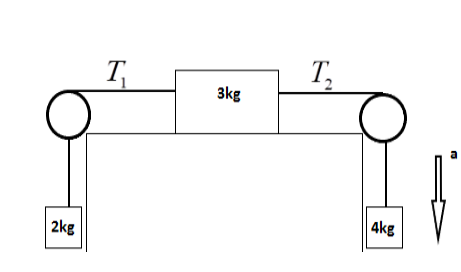
What is the acceleration $ a $ and the tension $ {T_1} $ and $ {T_2} $ in the given system?


Answer
525.6k+ views
Hint :In this question, we need to evaluate the tension in the wires and the acceleration of the block. For this, we will first make the free body diagrams of the blocks and then, use Newton’s third law equation for this question.
Complete Step By Step Answer:
There is no mention of friction coefficient here. Thus all surfaces are frictionless.
Since the strings are ideal, all the blocks have the same magnitude of acceleration though directions are different for different blocks.
The mass of the right block is more than the left block. Thus the right block will come down.
The respective equations of the blocks are as follows
$
4g - {T_1} = 4a \\
\Rightarrow {T_1} - {T_2} = 3a \\
\Rightarrow {T_2} - 2g = 2a \\
$
Adding all equations we get
$
4g - 2g = 9a \\
\Rightarrow 2g = 9a \\
\Rightarrow a = \dfrac{2}{9}g \\
\Rightarrow a = 2.22m{s^{ - 2}} \\
$
For the value of $ {T_1} $ we use the equation $ 4g - {T_1} = 4a $
Thus,
$
{T_1} = 4g - 4a \\
\Rightarrow {T_1} = 40 - 8.88 \\
\Rightarrow {T_1} = 31.12N \\
$
Again for $ {T_2} $ the value of it can be found by using the equation $ {T_2} - 2g = 2a $
Thus,
$
{T_2} = 2a + 2g \\
\Rightarrow {T_2} = 2 \times 2.22 + 20 \\
\Rightarrow {T_2} = 24.44N \\
$
Hence, the required answers are $ a = 2.22m{s^{ - 2}} $ , $ {T_1} = 31.12N $ and $ {T_2} = 24.44N $
Additional Information:
The law used here is Newton’s third law which states that the force is directly proportional to the change in momentum. Here the mathematical expression for this law is given by $ F = ma $ . This law is very useful in solving such types of questions.
Note :
The pulley used here is an ideal pulley and hence there is no friction in the rim and the pulley is massless. There are many arrangements of these types using multiple pulleys and surfaces in which friction may be used. Thus, students should be very skeptical about it and have a good amount of knowledge and practice while solving such questions.
Complete Step By Step Answer:
There is no mention of friction coefficient here. Thus all surfaces are frictionless.
Since the strings are ideal, all the blocks have the same magnitude of acceleration though directions are different for different blocks.
The mass of the right block is more than the left block. Thus the right block will come down.
The respective equations of the blocks are as follows
$
4g - {T_1} = 4a \\
\Rightarrow {T_1} - {T_2} = 3a \\
\Rightarrow {T_2} - 2g = 2a \\
$
Adding all equations we get
$
4g - 2g = 9a \\
\Rightarrow 2g = 9a \\
\Rightarrow a = \dfrac{2}{9}g \\
\Rightarrow a = 2.22m{s^{ - 2}} \\
$
For the value of $ {T_1} $ we use the equation $ 4g - {T_1} = 4a $
Thus,
$
{T_1} = 4g - 4a \\
\Rightarrow {T_1} = 40 - 8.88 \\
\Rightarrow {T_1} = 31.12N \\
$
Again for $ {T_2} $ the value of it can be found by using the equation $ {T_2} - 2g = 2a $
Thus,
$
{T_2} = 2a + 2g \\
\Rightarrow {T_2} = 2 \times 2.22 + 20 \\
\Rightarrow {T_2} = 24.44N \\
$
Hence, the required answers are $ a = 2.22m{s^{ - 2}} $ , $ {T_1} = 31.12N $ and $ {T_2} = 24.44N $
Additional Information:
The law used here is Newton’s third law which states that the force is directly proportional to the change in momentum. Here the mathematical expression for this law is given by $ F = ma $ . This law is very useful in solving such types of questions.
Note :
The pulley used here is an ideal pulley and hence there is no friction in the rim and the pulley is massless. There are many arrangements of these types using multiple pulleys and surfaces in which friction may be used. Thus, students should be very skeptical about it and have a good amount of knowledge and practice while solving such questions.
Recently Updated Pages
Why are manures considered better than fertilizers class 11 biology CBSE

Find the coordinates of the midpoint of the line segment class 11 maths CBSE

Distinguish between static friction limiting friction class 11 physics CBSE

The Chairman of the constituent Assembly was A Jawaharlal class 11 social science CBSE

The first National Commission on Labour NCL submitted class 11 social science CBSE

Number of all subshell of n + l 7 is A 4 B 5 C 6 D class 11 chemistry CBSE

Trending doubts
What is meant by exothermic and endothermic reactions class 11 chemistry CBSE

10 examples of friction in our daily life

One Metric ton is equal to kg A 10000 B 1000 C 100 class 11 physics CBSE

1 Quintal is equal to a 110 kg b 10 kg c 100kg d 1000 class 11 physics CBSE

Difference Between Prokaryotic Cells and Eukaryotic Cells

What are Quantum numbers Explain the quantum number class 11 chemistry CBSE




